Design ambient temperature for heating design and coolant
What determines the temperature of the radiators in a city apartment? Do GOST or SNiP regulate it? How is the temperature schedule of the heating system related to the climate zone? Let's try to answer these questions.
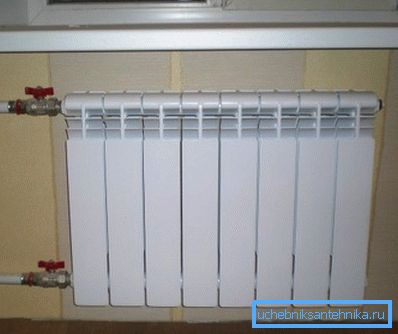
Calculated air temperature
The concept of the temperature of the heating period is not only related to the temperature schedule. They define the requirements for the degree of thermal insulation of a building, its size and heat flow from heating devices placed in residential and other premises, glazing and the quality of sealing of entrances.
So what is this concept? This is just the average temperature of the coldest five days of the last 50 years at which the operation of the heating system should provide comfortable conditions inside the buildings.
These conditions are described in the Resolution of the Government of the Russian Federation of May 23, 2006. The rules for the provision of public services to citizens
- In the living rooms located in the middle of the house, the temperature should not be lower than +18 С; in the corner - +20 C.
Nuance: at a design temperature below -31 C, these values increase to +20 and +22 degrees, respectively.
- The bathroom should be at least +16 degrees, in the bathroom - +25.
Recommendations for public institutions can be found in SNiP 41-01-2003 and departmental standards. So, in classrooms should be at least +21 C, and in food stores - +12 C; in the hospital, the recommended temperature after otoplasty is +22, and in case of deviations in the thyroid gland - +15.

Let's go back, however, a little back. Where does the designer get the estimated air temperature for a particular city?
All the necessary information is contained in SNiP 23-01-99 Building climatology. It is curious that in a document issued 8 years after the collapse of the Union, all the main settlements of the former Soviet republics are mentioned.
| City | Design temperature |
| Barnaul | -39 |
| Blagoveshchensk | -34 |
| Tynda | -42 |
| Belgorod | -23 |
| Voronezh | -26 |
| Bratsk | -43 |
| Kaliningrad | -nineteen |
| Kemerovo | -39 |
| Sochi | -3 |
| Igarka | -49 |
| Susuman | -55 |
| Verkhoyansk | -59 |
| Baku | -four |
| Yalta | -7 |
Temperature chart
What should be the temperature of heating radiators in the apartment, allowing to provide the described conditions?
It determines the average daily air temperature outside.
Dependence is described by two temperature graphs:
- For the heating main at the outlet from the CHP or boiler house, the temperature of the supply and return pipes is within 150/70 C.
- In an in-house system, the temperature regime of heating should be within the values of 95/70 degrees in a two-pipe system (that is, in almost all apartment buildings) and 105/70 in one-pipe heating systems of buildings.

Please note: in preschool institutions, the maximum water temperature in the heating system cannot exceed +37 C. It is to compensate for this low value that radiators in groups usually have very impressive dimensions.
Why is the heating temperature in the apartment so different from the parameters of the route? In order to answer this question, it is necessary to briefly explain the principle of operation of the elevator hub (thermal point of the house).
The requirements for the heating system are mutually exclusive in some way. On the one hand, the smaller the temperature variation between flow and return flow, the more uniformly the batteries in the house will be heated and the higher the efficiency of the end heaters will be. If so - it is obvious that the rate of circulation in the system should be quite high.
However, the overheating of the return line is extremely undesirable for CHP: due to certain technical limitations, the water before it starts up on the new cycle must first be pre-cooled to those 70 C.
The device of the elevator quite ingeniously avoids a contradiction: part of the water from the return pipeline is drawn into the repeated circulation cycle. As a result, when feeding at the inlet valves of 140 ° C to the house (directly to the radiators), there is only 90-95 degrees.

About a modern heating system in an apartment building it is useful to know a few more things.
- When the flow temperature on the highway is up to 90 degrees, the DHW system must be powered from the supply pipe; when this value is exceeded - from the reverse. If the switch does not happen, it may turn out to be as much in the DHW system as on the direct heating line. What consequences this will have for flexible connections and rubber gaskets is not difficult to guess.
- In critical situations, temperature standards in the heating system itself can also be exceeded. For example, in the case of mass complaints of cold in the apartments, the work of an elevator without a nozzle, with a muffled choke, is practiced.
Adjustment
How is the heating temperature controlled in the DH systems after the inlet valves?
Elevator
Normally, the heating temperature in the system can change only in one way - by changing the diameter of the nozzle. All changes should be agreed with representatives of the organization - supplier of heat (municipal heating networks); decisions about whether to brew the nozzle or drill out it are made on the basis of measurements of temperature and pressure in the elevator assembly and in the heat wells.
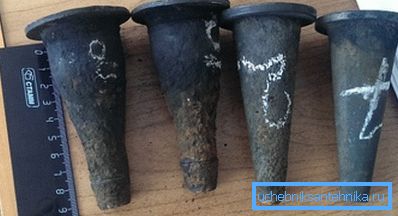
Dismantling the nozzle and changing its size takes no more than half an hour and requires full operability of the shut-off valves in the assembly. Actually, it is enough to block in a circle all the valves (input, DHW, brownies) and disassemble all three flanges on the elevator. The drilled or brewed nozzle is mounted in the reverse order.
Tip: new paronitic gaskets for pipe flanges are in the warehouses of housing organizations, alas, infrequently. When dismantling the elevator or replacing the valves with your own hands, simple instructions will help: the gasket is cut out of the car chamber.
It is worth mentioning a couple of ways in which the temperature of the heating can be regulated - water in the pipes and, accordingly, radiators.
- Instead of a conventional nozzle with a constant diameter, an adjustable elevator can be used. A simple adjustment of the flow rate allows you to flexibly adjust the temperature of the mixture and return flow.
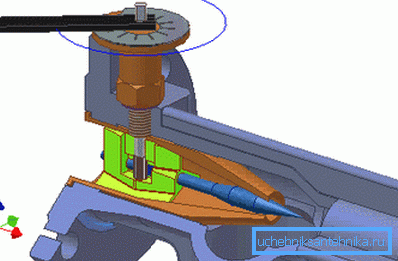
- In addition, to reduce the temperature of the return line, you can reduce the pressure drop across the elevator. This is done by an input return valve.
How exactly?
- DHW switches to straight line.
- The pressure on the supply line to the elevator is measured. The gauge is then screwed into the return pipe at any point.
- The inlet return valve closes completely and slowly opens until the pressure difference between the supply and return pipelines decreases by 0.2 kgf / cm2 from the original. If necessary, repeated measurements of temperatures and a further decrease in the differential pressure on the manometer is repeated every other day with the same step.
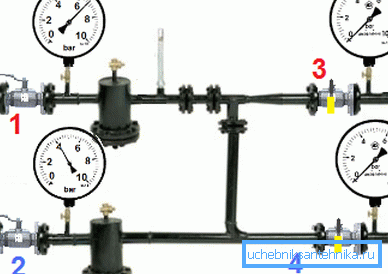
Please note: if you simply partially close a fully open valve, its cheeks may be stuck in the stem and lower into the working position later. As a result, the return line will be completely closed. Price stop circulation in the heating season - guaranteed defrosting of access heating.
Apartment
How is the temperature of water in the heating pipes inside a separate apartment regulated? For obvious reasons, it can only be reduced by throttling valves. For this purpose, at the outlet of each heater, a choke or thermostatic head is placed, which regulates its own permeability depending on the temperature in the room.
In the extreme case, the temperature of the coolant in the heating system can be regulated by a ball valve; however, its sensitivity to the position of the lever makes the adjustment rather inconvenient.
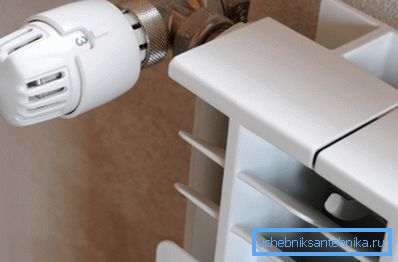
What to do if the heat output of the heater is insufficient?
Here are the measures that can increase it.
- Simply adding new sections from the far end of the liner will raise the heat flow from the radiator nonlinearly, but quite noticeably. Why nonlinear? Yes, because the end of the battery will always be colder than its connections.
- The jumper between the supply lines, equipped with a valve, is capable of increasing the flow of coolant through the sections when it is closed. So, the device will give more heat. But you do not need to completely jam the jumper: without it, adjusting the temperature of the radiators with chokes will lead to rather unpleasant communication with freezing neighbors.
- Leads can be connected to the radiator not only the assembly, but also the bottom. Then the coolant will circulate evenly through all sections, which will also raise the temperature in the apartment.
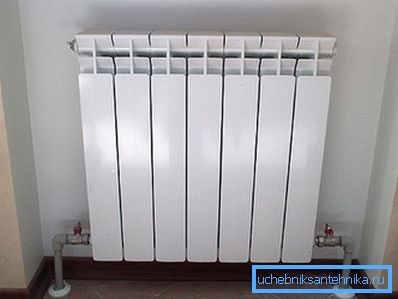
- Finally, don't forget about washing.. The discharge of water through the flush valve and the hose into the sewage system will remove accumulated sludge and sand from the battery, restoring circulation to the whole volume.
By the way: radiators with bottom connection do not need flushing. Precisely because the coolant evenly moves along the entire length of the lower collector.
Warm floor
How to connect low-temperature heating to the DH system? Indeed, for a warm floor, temperatures above + 45C are categorically unacceptable.
The way in which low-temperature heating systems are consistent with the DH, vividly recalls the principle of operation of the elevator hub. Part of the coolant is involved in re-circulation, which is provided by a low-power pump. Temperature adjustment is carried out by a two-way valve with thermal head.
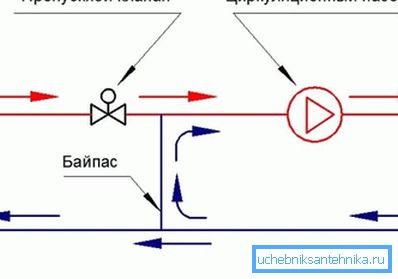
Conclusion
We hope that we were able to satisfy the reader’s curiosity by introducing him to some aspects of the operation of heating systems. As always, the attached video will offer additional information. Successes!